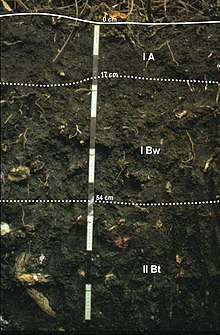Phaeozem
A Phaeozem in the World Reference Base for Soil Resources (WRB) is a dark soil with a high base status, but without a secondary carbonates within one metre of the soil surface. Phaeozems correlate with the Udolls and Aquolls (Mollisols) of the USDA soil taxonomy.[1][2]

Luvic Phaeozem in Luqmuts, Ethiopia
Distribution of phaeozems
These soils are found mainly in humid and sub-humid tall-grass steppes; there are extensive areas of them in the United States, Argentina and China. Phaeozems form from unconsolidated sediments such as loess and glacial till and typically have organic matter contents of about 5% and a pH of 5–7.
Intensive agricultural use is widespread and includes wheat, soybean and cotton production and improved pastures for cattle.
See also
References
- IUSS Working Group WRB: World Reference Base for Soil Resources 2014, Update 2015. World Soil Resources Reports 106, FAO, Rome 2015. ISBN 978-92-5-108369-7 (PDF 2,3 MB).
- Delvaux, B.; Brahy, V. "Mineral Soils conditioned by a Wet (Sub)Tropical Climate". FAO. Retrieved 14 June 2014.
- "Major Soils of the World. ISRIC Wageningen, The Netherlands, 2001" (PDF). Archived from the original (PDF) on 2016-03-04. Retrieved 2014-06-14.
External links
- profile photos (with classification) WRB homepage
- profile photos (with classification) IUSS World of Soils
This article is issued from Wikipedia. The text is licensed under Creative Commons - Attribution - Sharealike. Additional terms may apply for the media files.